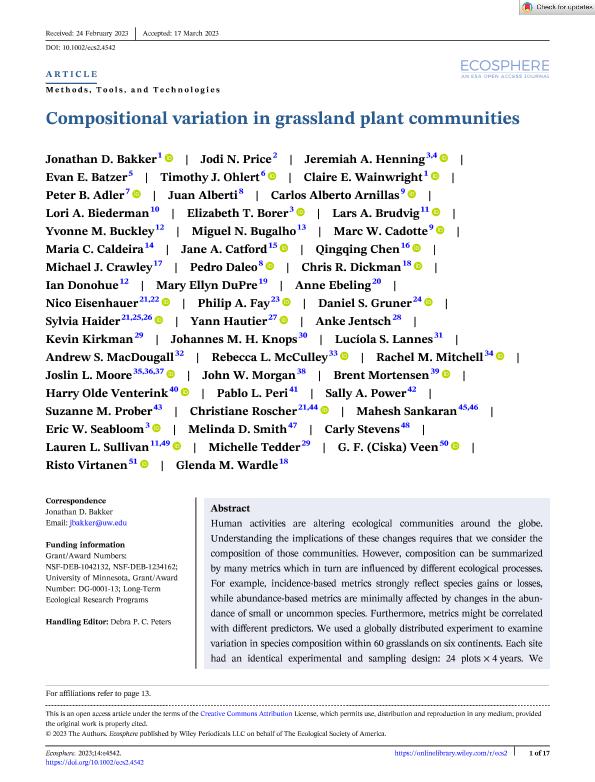Artículo
Compositional variation in grassland plant communities
Bakker, Jonathan; Price, Jodi N.; Henning, Jeremiah A.; Batzer, Evan E.; Ohlert, Timothy; Wainwright, Claire E.; Adler, Peter; Alberti, Juan ; Arnillas, Carlos Alberto; Biederman, Lori A.; Borer, Elizabeth; Brudvig, Lars A.; Buckley, Yvonne M.; Bugalho, Miguel N.; Cadotte, Marc W.; Caldeira, Maria C.; Catford, Jane A.; Qingqing, Chen; Crawley, Michael J.; Daleo, Pedro
; Arnillas, Carlos Alberto; Biederman, Lori A.; Borer, Elizabeth; Brudvig, Lars A.; Buckley, Yvonne M.; Bugalho, Miguel N.; Cadotte, Marc W.; Caldeira, Maria C.; Catford, Jane A.; Qingqing, Chen; Crawley, Michael J.; Daleo, Pedro ; Dickman, Chris R.; Donohue, Ian; DuPre, Mary Ellyn; Eisenhauer, Nico; Peri, Pablo Luis
; Dickman, Chris R.; Donohue, Ian; DuPre, Mary Ellyn; Eisenhauer, Nico; Peri, Pablo Luis ; Roscher, Christiane; Tedder, Michelle; Veen, G. F.; Virtanen, Risto; Wardle, Glenda M.
; Roscher, Christiane; Tedder, Michelle; Veen, G. F.; Virtanen, Risto; Wardle, Glenda M.
 ; Arnillas, Carlos Alberto; Biederman, Lori A.; Borer, Elizabeth; Brudvig, Lars A.; Buckley, Yvonne M.; Bugalho, Miguel N.; Cadotte, Marc W.; Caldeira, Maria C.; Catford, Jane A.; Qingqing, Chen; Crawley, Michael J.; Daleo, Pedro
; Arnillas, Carlos Alberto; Biederman, Lori A.; Borer, Elizabeth; Brudvig, Lars A.; Buckley, Yvonne M.; Bugalho, Miguel N.; Cadotte, Marc W.; Caldeira, Maria C.; Catford, Jane A.; Qingqing, Chen; Crawley, Michael J.; Daleo, Pedro ; Dickman, Chris R.; Donohue, Ian; DuPre, Mary Ellyn; Eisenhauer, Nico; Peri, Pablo Luis
; Dickman, Chris R.; Donohue, Ian; DuPre, Mary Ellyn; Eisenhauer, Nico; Peri, Pablo Luis ; Roscher, Christiane; Tedder, Michelle; Veen, G. F.; Virtanen, Risto; Wardle, Glenda M.
; Roscher, Christiane; Tedder, Michelle; Veen, G. F.; Virtanen, Risto; Wardle, Glenda M.
Fecha de publicación:
06/2023
Editorial:
Wiley
Revista:
Ecosphere
ISSN:
2150-8925
Idioma:
Inglés
Tipo de recurso:
Artículo publicado
Clasificación temática:
Resumen
Human activities are altering ecological communities around the globe. Understanding the implications of these changes requires that we consider the composition of those communities. However, composition can be summarized by many metrics which in turn are influenced by different ecological processes. For example, incidence-based metrics strongly reflect species gains or losses, while abundance-based metrics are minimally affected by changes in the abundance of small or uncommon species. Furthermore, metrics might be correlated with different predictors. We used a globally distributed experiment to examine variation in species composition within 60 grasslands on six continents. Each site had an identical experimental and sampling design: 24 plots × 4 years. We expressed compositional variation within each site—not across sites—using abundance- and incidence-based metrics of the magnitude of dissimilarity (Bray–Curtis and Sorensen, respectively), abundance- and incidence-based measures of the relative importance of replacement (balanced variation and species turnover, respectively), and species richness at two scales (per plot-year [alpha] and per site [gamma]). Average compositional variation among all plot-years at a site was high and similar to spatial variation among plots in the pretreatment year, but lower among years in untreated plots. For both types of metrics, most variation was due to replacement rather than nestedness. Differences among sites in overall within-site compositional variation were related to several predictors. Environmental heterogeneity (expressed as the CV of total aboveground plant biomass in unfertilized plots of the site) was an important predictor for most metrics. Biomass production was a predictor of species turnover and of alpha diversity but not of other metrics. Continentality (measured as annual temperature range) was a strong predictor of Sorensen dissimilarity. Metrics of compositional variation are moderately correlated: knowing the magnitude of dissimilarity at a site provides little insight into whether the variation is driven by replacement processes. Overall, our understanding of compositional variation at a site is enhanced by considering multiple metrics simultaneously. Monitoring programs that explicitly incorporate these implications, both when designing sampling strategies and analyzing data, will have a stronger ability to understand the compositional variation of systems and to quantify the impacts of human activities.
Palabras clave:
BRAY–CURTIS DISSIMILARITY
,
FERTILIZATION
,
SPECIES COMPOSITION
,
GRASSLAND
Archivos asociados
Licencia
Identificadores
Colecciones
Articulos(IIMYC)
Articulos de INSTITUTO DE INVESTIGACIONES MARINAS Y COSTERAS
Articulos de INSTITUTO DE INVESTIGACIONES MARINAS Y COSTERAS
Citación
Bakker, Jonathan; Price, Jodi N.; Henning, Jeremiah A.; Batzer, Evan E.; Ohlert, Timothy; et al.; Compositional variation in grassland plant communities; Wiley; Ecosphere; 14; e454; 6-2023; 1-17
Compartir
Altmétricas



